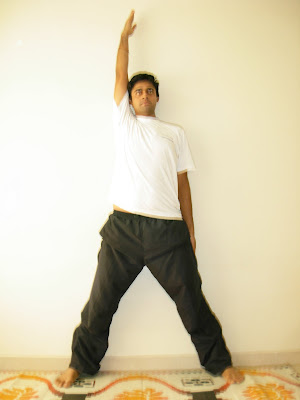Obesity is one of the major diseases of our modern times. Obesity is not merely a disease in itself, but a chief cause for the birth of various other diseases. Obesity leads to diabetes, heart diseases and also affects our emotional and mental balance. Obesity is the deposition on excessive fat on the body which occurs due to lack of exercise or activity, low metabolism, bad eating habits and hypo-thyroid. With the intake of balance diet, good life style and regular practice of yoga, one can avoid being obese in his or her lifetime.
Asana for obesity: Surya Namaskar1. Stand, facing the sun with both feet together, join the hands near the chest

2. Start inhaling and start raising the arm above the head and start bending the back backwards. The arms must touch the ears.

3. Exhale and start bending forward to touch the palms on the ground next to the feet and the head touching the knee; make sure not to bend the knees.

4. Inhale and take the right foot away from the body in the backward direction, raise the chin as high as possible. Keep the hands and legs firm.

5. Exhaling, move the left leg next to the right leg and start raising the hip. (to form a inverted V like shape)

6. Now, slowly lower your body so that the chest, knees palms, toes and chin touch the ground. Every thing else is in mid air.

7. Inhaling, touch the waist on the ground and raise the torso by straightening the hands and bending the back as much as possible.

8. Exhaling, raise the hip from the ground and try to touch the heels to the ground and the chin to the chest (to form a inverted V like shape)

9. Inhale and bring the left leg forward between the hands, raise the chin as high as possible.

10. Exhale and bring the right leg next to the left leg so that your palms are next to the legs and the head is touching the knee. Don’t bend the knee.

11. Inhale and raise the arm above the head and start bending the back backwards. The arms must touch the ears.

12. Come back to position no 1 with your hands joint next to the chest.

Surya namaskar should be practiced 12 times in the morning to reduce weight.
 This is a relaxation posture in which all the muscles are relaxed in this position and so they require less blood and oxygen supply. Consequently, the heart beats and the breathing also slows down. Therefore, the body gets good rest. Abdominal muscles get automatic massage. This is specifically beneficial in Asthma.
This is a relaxation posture in which all the muscles are relaxed in this position and so they require less blood and oxygen supply. Consequently, the heart beats and the breathing also slows down. Therefore, the body gets good rest. Abdominal muscles get automatic massage. This is specifically beneficial in Asthma.
























